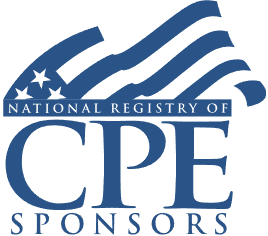Avoiding IRS Audit Red Flags: IRS' DIF Score, LB&I vs. Correspondence Exams, Statutes of Limitation

Course Details
- smart_display Format
On-Demand
- signal_cellular_alt Difficulty Level
Intermediate
- work Practice Area
Tax Preparer
- event Date
Wednesday, July 6, 2022
- schedule Time
1:00 p.m. ET./10:00 a.m. PT
- timer Program Length
110 minutes
-
BARBRI is a NASBA CPE sponsor and this 110-minute webinar is accredited for 2.0 CPE credits.
-
BARBRI is an IRS-approved continuing education provider offering certified courses for Enrolled Agents (EA) and Tax Return Preparers (RTRP).
This webinar will give a first-hand look at how the Internal Revenue Service selects tax returns for audit. Our IRS veteran will provide insights into the different levels of IRS examinations, appropriate responses, and how to avoid the expansion or escalation of an audit.
Faculty

Mr. Myers is a valuable asset to the tax practitioner community. He speaks at numerous seminars and continuing education events on a variety of subjects ranging from IRS culture and processes to technical topics based on his decades of experience. Mr. Myers spent over 30 years with the IRS with his last 20 years as a Sr. Technical Advisor for Washington DC.
Description
There are indeed red flags that can raise a taxpayer's DIF score. Certainly, individuals submitting information that differs from amounts reported by third parties can expect a notice. But do rounded numbers, large deductions, or having a home office raise your DIF score? In 2019 the IRS audited only .4 percent of returns received. The agency is on a hiring spree, and increased audits are a certainty.
When a taxpayer is audited, taxpayers and practitioners should tailor responses based on the type of IRS audit and who is conducting the examination. An IRS inquiry could be face-to-face or conducted by mail, as a business or individual examination. Expectations of an LB&I examiner differ significantly from those of IRS personnel conducting a technical correspondence examination. Most concerning is that a low-level correspondence audit can blossom into an audit of a taxpayer's whole enterprise. Taxpayers and tax professionals need to know what items trigger an IRS audit and how to best respond to all types of IRS inquiries.
Listen as our experienced IRS consultant divulges red flags that could trigger an IRS audit and best practices for evading IRS inquiries.
Outline
- IRS audits: introduction
- DIF score
- Audit triggers
- Types of audit
- Record retention
- Statutes of limitation
- Appeals
Benefits
The panel will review these and other critical issues:
- How is the IRS' DIF score used to select tax returns for an audit?
- What steps can tax professionals take to reduce the chances of a return being selected for audit?
- What are the different types of examinations conducted by the IRS?
- When does an audit of one return or item expand into an audit of all of a taxpayer's undertakings?
- How should a tax practitioner respond to a mail-in audit request?
- How do the applicable statutes of limitation affect an examination?
NASBA Details
Learning Objectives
After completing this course, you will be able to:
- Identify returns most likely chosen for an audit
- Determine how a substantial understatement of income affects the statute of limitations on audits
- Decide how many years to retain certain taxpayer records
- Ascertain differences in responses to audit inquiries based on the type of examination
- Field of Study: Taxes
- Level of Knowledge: Intermediate
- Advance Preparation: None
- Teaching Method: Seminar/Lecture
- Delivery Method: Group-Internet (via computer)
- Attendance Monitoring Method: Attendance is monitored electronically via a participant's PIN and through a series of attendance verification prompts displayed throughout the program
- Prerequisite: Three years+ business or public firm experience preparing complex tax forms and schedules, supervising other preparers or accountants. Specific knowledge and understanding of individual income taxation, including itemized deductions, individual income tax credits, net operating loss limitations including carrybacks and carryforwards.

Strafford Publications, Inc. is registered with the National Association of State Boards of Accountancy (NASBA) as a sponsor of continuing professional education on the National Registry of CPE Sponsors. State boards of Accountancy have final authority on the acceptance of individual courses for CPE Credits. Complaints regarding registered sponsons may be submitted to NASBA through its website: www.nasbaregistry.org.

Strafford is an IRS-approved continuing education provider offering certified courses for Enrolled Agents (EA) and Tax Return Preparers (RTRP).
Unlimited access to premium CLE courses:
- Annual access
- Available live and on-demand
- Best for attorneys and legal professionals
Unlimited access to premium CPE courses.:
- Annual access
- Available live and on-demand
- Best for CPAs and tax professionals
Unlimited access to premium CLE, CPE, Professional Skills and Practice-Ready courses.:
- Annual access
- Available live and on-demand
- Best for legal, accounting, and tax professionals
Unlimited access to Professional Skills and Practice-Ready courses:
- Annual access
- Available on-demand
- Best for new attorneys
Related Courses

2025 Tax Legislation: The One Big Beautiful Tax Bill Act
Thursday, July 31, 2025
1:00 p.m. ET./10:00 a.m. PT

Section 1202 Qualified Small Business Stock: OBBBA’s Expanded Benefits and Opportunities
Monday, July 28, 2025
1:00 p.m. ET./10:00 a.m. PT
Recommended Resources
How CPE Can Bridge the Gap Between What You Know and What You Need to Know
- Career Advancement